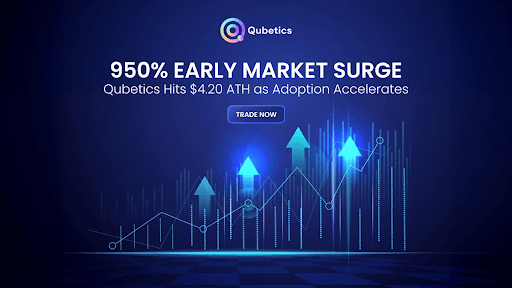OKB, the native utility token of the OKX exchange, has cemented its position in the top-tier crypto ecosystem. As of mid-2025, OKB is trading around $49 with a market cap of approximately $3 billion and is gaining renewed interest following its resurgence from the March 2024 all-time high of $73.83. Meanwhile, Qubetics, a recently launched Layer-1 blockchain project, has stunned the market with a 420x surge, triggering a new round of speculation around long-term ROI potential in platform-native tokens. This spotlight focuses on OKB price prediction 2030 and explores whether it could emulate Qubetics‘ explosive trajectory.
With Qubetics trending among the top 10 cryptocurrencies on CoinMarketCap and already deployed on major platforms like MEXC, LBank, and SWFT Bridge, parallels are increasingly drawn between its tokenomics and OKB’s more mature structure. While the paths differ, the question arises: Can OKB experience a similar surge by the end of the decade?
The Foundation of OKB’s Long-Term Value: Utility Meets Scarcity
OKB was launched as a native token to provide ecosystem utility within OKX, one of the world’s largest crypto exchanges by volume. OKB enables users to pay trading fees, participate in token sales, earn passive income through staking, and influence ecosystem governance.
Token scarcity is a defining feature of OKB’s long-term strategy. Out of the 300 million maximum supply, only 60 million tokens are currently in circulation. This controlled float is coupled with a robust buyback-and-burn mechanism funded by 30% of OKX’s spot trading revenue. These deflationary pressures create a favorable backdrop for long-term appreciation, especially if exchange usage and adoption continue to rise.
The projected price appreciation of OKB hinges on three pillars: exchange growth, token utility, and adoption of decentralized services within the OKX ecosystem. Should these continue trending upward, analysts project OKB may enter the $200–$250 range by 2030, with optimistic models placing it as high as $500, assuming sustained platform dominance and wider DeFi integration.
How the OKX Ecosystem Drives OKB Performance
OKX has evolved beyond a centralized trading platform into a multi-layered blockchain service provider. It now offers a Layer-1 chain (OKT Chain), a decentralized exchange (OKX DEX), and Web3 wallet infrastructure. Each of these modules is designed to reinforce OKB’s use case.
DeFi participation, staking, governance, and access to exclusive token launchpads are central to OKB’s appeal. OKX Jumpstart, for instance, allows OKB holders to participate in curated token launches. This direct participation model enhances demand during bullish cycles and contributes to token velocity.
Real-world application of the OKX Wallet and ongoing OKB integrations in metaverse platforms, NFT ecosystems, and cross-chain liquidity hubs are enhancing long-term sustainability. As Layer-2 and cross-chain protocols mature, OKB’s utility is expected to expand beyond the exchange, driving deeper ecosystem involvement.
Current Market Sentiment and Technical Indicators
OKB is currently consolidating between $45 and $52. The Relative Strength Index (RSI) sits near 50, suggesting market neutrality. The MACD line is nearing a bullish crossover, indicating a potential upward move in the coming months.
Trading volume remains moderate at $7 to $9 million per day, with spikes during broader market rallies. As macro sentiment shifts toward risk-on assets, OKB has shown resilience relative to other exchange tokens. Analyst models from DigitalCoinPrice and CoinCodex project a realistic 2030 range of $200 to $250, assuming no major disruptions in regulatory policy or exchange infrastructure.
Potential Roadblocks in OKB’s 2030 Trajectory
Despite its strengths, OKB faces several risks. Chief among them is regulatory exposure. Centralized exchanges are increasingly under scrutiny by regulators in the US, Europe, and Asia. A potential clampdown on exchange operations or token issuance could constrain future price growth.
Moreover, OKB’s value is intrinsically tied to the performance of OKX. Any decline in platform reliability, security, or market share could negatively impact the token. Unlike fully decentralized assets, OKB’s dependence on a centralized issuer introduces counterparty risk.
Additionally, market competition from Binance Coin (BNB), Cronos (CRO), and other utility tokens means OKB must continuously innovate to retain its market share.

Qubetics and the Rise of Infrastructure-First Tokens
While OKB progresses steadily, Qubetics has captured headlines with its infrastructure-first Layer-1 architecture. The token surged 950% within its first hour of launch, climbing from a $0.40 listing price to an all-time high of $4.20 on MEXC and LBank.
Qubetics offers a modular, non-custodial multi-chain wallet experience, enabling users to interact across blockchains with private key ownership and seamless asset transfer. This decentralized, user-first design sharply contrasts with custodial wallets, and it’s attracting early adoption from DeFi users and developers.
The Qubetics wallet supports cross-chain compatibility and operates as a gateway for applications including decentralized VPNs, tokenized RWA platforms, and AI-integrated dApps. These features are not hypothetical, they’re already being piloted in sandbox environments.
Presale Performance and ROI Potential for Qubetics
Qubetics has emerged as the best crypto ico to invest in 2025. Beginning at $0.01 in Stage 1 and ending at $0.3370 by Stage 37, the token appreciated over 3,270% even before its exchange debut. The listing on June 30 acted as a pivotal moment, pushing the token to 10.5x gains within 60 minutes of going live. Trade volume on MEXC topped $700,000 in the first 24 hours. A strong support level has formed around $2.00, with persistent buying interest suggesting a long-term accumulation zone.
Analysts now forecast a price range of $5 to $10 for Qubetics during the next cycle. Some long-term projections suggest $15 post-mainnet, supported by rising developer engagement and token utility.
The listing is more than a liquidity event. It marked the transition to broader developer onboarding, institutional trading desk access, and increased token velocity. As of now, Qubetics remains in the CoinMarketCap top 10 trending assets, indicating ongoing interest and capital flow.
Comparing Growth Curves: Can OKB Match Qubetics’ Trajectory?
While Qubetics achieved 420x gains from presale to ATH in a matter of months, OKB has followed a slower but steadier curve. Launched in 2018, OKB took years to cross the $50 mark and only reached its ATH in March 2024.
Qubetics’ rise is tied to its disruptive architecture and early-stage narrative. OKB’s growth is dependent on exchange metrics and steady platform adoption. The risk-reward profile differs significantly.
However, should OKX embrace deeper decentralization, grow its user base, and innovate its wallet and DEX platforms, OKB could still see multi-fold gains over the next five years. Unlike speculative Layer-1 launches, OKB’s slower trajectory also reflects its relatively lower downside risk.
OKB Price Prediction 2030: Final Forecast and Strategic Considerations
The baseline forecast for OKB in 2030 ranges between $200 and $250, with bullish targets near $500. These estimates depend on OKX’s ecosystem expansion, user growth, and regulatory clarity. Technical indicators suggest medium-term consolidation, with potential bullish breakout if volume sustains.
While a Qubetics-style 420x return seems unlikely for OKB at this stage of maturity, a 4x to 10x return remains plausible under favorable market dynamics. The key lies in continued platform innovation, enhanced token utility, and adoption of decentralized features within the OKX environment.
For participants seeking structured exposure in a utility-driven token, OKB offers long-term value through steady ecosystem growth. For those pursuing asymmetric upside with emerging infrastructure, Qubetics presents a high-risk, high-reward opportunity.
Conclusion: Strategic Assets in a Dual-Track Market
OKB and Qubetics represent distinct categories of crypto assets. OKB is an exchange-native utility token with a proven track record and deflationary tokenomics. Qubetics, on the other hand, is a fast-moving Layer-1 ecosystem with cutting-edge applications and early-stage momentum.
While OKB’s price prediction for 2030 points toward sustainable long-term growth, it is unlikely to match Qubetics’ immediate 420x surge. Still, its structural reliability and exchange integration make it one of the most stable tokens to hold in a volatile market.
Qubetics continues to push the limits of ROI with its modular wallet, developer adoption, and trending status. As the crypto market matures, both tokens offer distinct opportunities, depending on one’s risk tolerance and time horizon.
For More Information:
Qubetics: https://qubetics.com
Telegram: https://t.me/qubetics
Twitter: https://x.com/qubetics
Summary:
This article explores the long-term growth potential of OKB, OKX’s native utility token, through the lens of price predictions for 2030. While OKB offers steady growth driven by token scarcity, exchange utility, and a deflationary model, it faces regulatory and competitive pressures. Analysts forecast OKB reaching $200–$500 by 2030. In contrast, Qubetics recently stunned the market with a 420x surge post-launch, thanks to its non-custodial multi-chain wallet and early developer adoption. The article compares both assets, concluding that while OKB is a reliable, utility-driven token, Qubetics presents a high-risk, high-reward opportunity.




